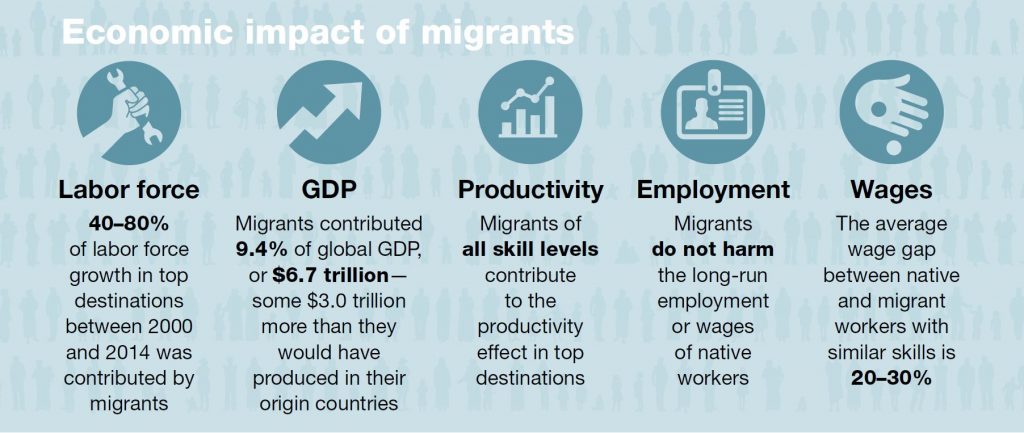 Few issues stir up such strident opinion as migration. From the wish to control borders and protect jobs and communities, to the need to open the door wide and welcome workers with the skills required to run a vibrant economy – the fault lines are well formed.
Few issues stir up such strident opinion as migration. From the wish to control borders and protect jobs and communities, to the need to open the door wide and welcome workers with the skills required to run a vibrant economy – the fault lines are well formed.
So which side is right? Well, the data shows that both sides are right – up to a point. It depends on where one’s thinking has its origin.
Migration issues were amplified last week with the publication of the latest Office of National Statistics (ONS) quarterly report on UK immigration and emigration. The headlines followed with news that annual immigration in June stood at an all-time high of 650,000, although the actual trend over the previous 18 months has been almost flat.
With emigration also rising, the net migration into the UK was 335,000 and comprised 189,000 European Union citizens together with 196,000 individuals from outside the EU.
It should be recognised from the outset that the interpretation of these numbers requires more finesse than headlines allow.
In particular, 163,000 of recorded arrivals in the UK were students – the lowest figure since 2007. Twenty two per cent of EU citizens and 73 per cent of non-EU individuals came to study in the UK’s colleges and universities. This group brings benefits into the UK, as reported in Chief-Exec.com, and clearly the socio-economic consequences of their arrival are different to those in search of employment. This and further interpretation of migration statistics are explained in an ONS blog.
The zeal of Prime Minister Theresa May to reduce immigration to the “tens of thousands” impacts hard on a reality that is at least 335 per cent over her target. This, in turn, increases the entropy in the Brexit negotiations which will hinge on a trade-off between limitations of freedom of movement for European citizens and the imposition of trade barriers between the EU and UK.

Key Points: People on the move: Global migration’s impact and opportunity, McKinsey Global Institute
With impeccable timing, last week also saw the publication of a report on People on the move: Global migration’s impact and opportunity by the McKinsey Global Institute. Here one discovers that migration is enormously beneficial to the global economy, and also to those nations that are recipients of migrant labour. Few countries, however, are good at accommodating migrants and fully benefiting from their productive capability.
A recent Office of Budget Responsibility (OBR) estimate of the cost to UK taxpayers of curbing immigration put it at £16 billon – that is £855 for every family in the UK – over the next five years.
Information available in the ONS migration and employment datasets provide an insight into how the UK might reconcile the highly divergent opinions on the pros and cons of migration.

The chart above shows how the UK workforce has changed in total number of workers and also in its national composition, since 2007 – just before the global financial crisis.
The depressed years: 2008 – 2012
In the midst of the gloom of the depressed economy, UK worker numbers fell. Unemployment reached a peak of 8.5 per cent around October 2011. About that time 571,810 British workers jobs had been lost. Yet 437,569 EU workers and 392,151 Non-EU workers had entered the UK labour market since 2007.
It is not difficult to interpret these numbers in terms of substitution. Yes, migrant labour did make up for jobs lost by UK workers, so that overall employment remained relatively unchanged. Perhaps the substitution also depressed wages. Large scale arrivals of working migrants into communities, perhaps co-located with neighbours exposed to the uncertainties and losses of the depression, could explain social tensions without resort to xenophobic reasons. Difficulties in getting on the housing ladder, getting doctors’ appointments and school places, together with overwhelming demand for finite social services could reasonably combine in the mind of the British citizen – the voter – to lead them to conclude that migration is bad.
This was only five years ago and, while times have changed, the memories will have endured, as indeed may have many individual experiences.
Towards a brighter future: 2012 – 2017
The above chart also reveals the unrelenting growth of UK employment since 2012. The 2007 level of UK worker participation in the nation’s labour market had been restored by 2013 and since then a further 600,000 UK workers have found employment.
Levels of unemployment in the UK now sit at 4.8 per cent. This is close to a historic low that has existed since 1973 – though further capacity increases could be achieved with moves from part- to full-time employment. Otherwise, further reductions become increasingly difficult with the matching of skills to available jobs. It could also lead to accelerated inflation as demand for labour exceeds its supply.

GDP growth rates, quarter-on-quarter indexed Q1 2008 =100. Credit: ONS
Today, added to the high UK worker participation, there are about two million individuals working in the UK who were born overseas. It is in part due to these contributors that the UK economy is performing better than its European neighbours. Over the past year GDP has risen by 2.6 per cent. GDP per head has done less well, increasing by 1.5 per cent, but this still registers an improving prosperity for the UK population.
In the ONS data we have seen that, since 2012, 2,296,000 workers from all origins have been added to the UK labour market. This growth has, in part, made up for the lack of worker productivity that we have noted in Chief-Exec.com. Moves by the Chancellor, Philip Hammond, in his Autumn Statement last month to address this productivity problem will take time to produce fruit.
Brexit and beyond: 2017 –
Historians might look back and conclude that Brexit was a consequence of a juxtaposition of two significant events – a profound economic depression in the UK alongside an unprecedented wave of migration into the country.
What happens next with migration will become a primary determinant of the strength of the UK economy. A number of sectors are already sounding the alarm. In Chief-Exec.com we have covered the need for skills in particular areas such as Universities, Tourism and the Creative Industries.
Cabinet ministers and government officials are already making a case for immigration to provide lower skilled workers in agriculture, hospitality, construction and social care, according to a recent SkyNews report.
An imminent shortage of seasonal workers has been identified in a survey released on Monday by the National Farmers Union, in which 46.7 per cent of respondents said that supply was not sufficient to meet demand. In a letter to Robert Goodwill, Minister of State for Immigration, seen by Chief-Exec.com, Minnette Batters, NFU deputy president refers to a “clear emerging labour crisis in the industry”.

Without a scheme for non-EU seasonal migrants to make up the shortfall of agricultural workers in 2017, “British fruit and vegetables will be left to rot unpicked in British fields”, she wrote.
Other agricultural sectors require a flexible and permanent workforce for which existing EU workers need to be retained, Ms Batters said. “It is essential that the Government sends out positive messages to make clear that EU citizens already living and working here should have right of residency post the referendum decision”.
Changing perceptions of migration are part of a long story of the position of the UK in Europe and in the world. It is a mistake to imagine these are immutable and to be insensitive to their impact on the ability of an economy to provide self-sufficiency and prosperity.
This look back into very recent history of migration into the UK serves to help us understand how we got to where we are.
Next week we will look at where we are going in the future.
By John Egan




